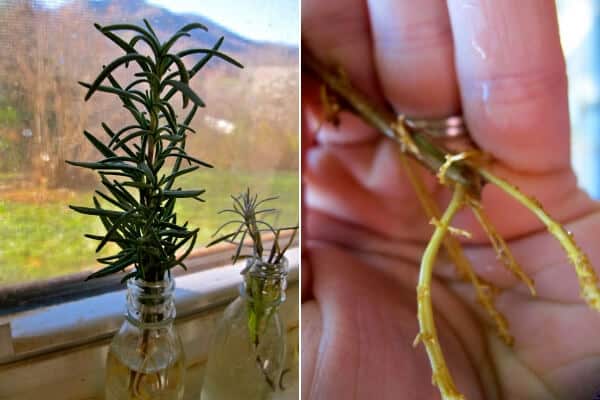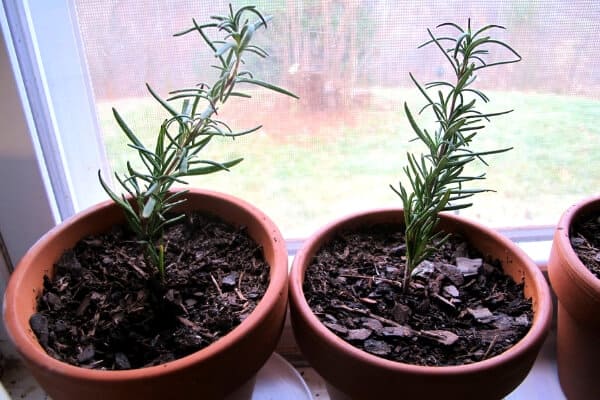Rosemary has always been one of my favorite herbs. It is fragrant, and as useful and beneficial as it is beautiful!
Growing rosemary is super easy, as is growing most herbs, and it is a perennial that will continue to produce and grow for many years with the correct care.
This site contains affiliate links. If you make a purchase using one of these links, I may earn a commission. Please see my disclosure page for more information about cookies collected and our privacy policy.
So before we get to how to grow rosemary, let’s talk about what it is. Rosemary, or rosmarinus officinalis, is a aromatic, woody perennial with evergreen, needle like leaves. Depending on the variety you are growing it will produce white, pink, purple, or bluish flowers.
Now let’s take a look at the various ways you can get started growing rosemary at home.
How to Get Started Growing Rosemary at Home
There are 3 main ways you can get started growing rosemary, they are:
Purchase Rosemary Plants
This is the simplest way to get started with rosemary. Simply go to your local garden center and pick up a plant of potted rosemary. Be sure to choose a plant that looks healthy and vibrant.
Rosemary can be sensitive to colder temperatures, so if your live in an area that gets into the teens or lower in the winter you will want to choose a variety that is more hardy. Or read below on how to grow rosemary from cuttings to propagate more each winter in case your existing plant doesn’t make it through a cold winter.
Grow Rosemary from Cuttings
Growing rosemary from cuttings is my favorite way to get rosemary plants. If you have a friend with a rosemary plant then this is a good choice for you!
Simply cut a stem of rosemary and strip off the bottom leaves and stick in a jar of water. (I use tiny bottles from Cracker Barrel syrup, one for each stem). After a few weeks you will see roots growing from the stem.
Once the cutting has a good set of roots, plant into a pot filled with potting soil and good drainage.
You can root these cuttings in the fall and overwinter your new rosemary plants indoors and plant out in the spring once the threat of frost has passed.
Start Rosemary from Seed
And finally, you can start rosemary from seed. Starting rosemary from seed can be challenging, and unless you really want to or want a very particular variety of rosemary, I would choose one of the above 2 ways to get started instead.
If starting rosemary from seed, plant the seeds indoors 8-10 weeks before last frost.
Sow the seeds on the top of the soil, just barely covering. The seeds need warm temperatures and soil temperatures between 80-90 degrees for good germination.
Rosemary seedlings can be prone to damping off so don’t over water and provide lots of light and ventilation.
Again, this is one of the more difficult ways to grow rosemary, and even large nurseries propagate cuttings instead of starting by seed!
How to Care for Your Growing Rosemary Plants
Rosemary is a very simple, low need plant. Plant it in good, well drained soil in a sunny location and you will be good to go. But, here are some specifics:
Rosemary prefers full sun, so aim for a location with at least 6-8 hours of full sun a day.
Rosemary can be very prone to root rot, so light soil with good drainage is a must.
Adding mulch around your plants can help keep the soil moist in the summer and protect roots in the winter.
When planting rosemary remember that it can grow quite large, so be sure to give it room to grow. Some plants get grow up to 6 feet in warmer areas!
There are 2 types of rosemary: upright and trailing. Common upright varieties are Tuscan Blue, Tuscan Spires, or Miss Jessup. Trailing varieties are ones like Huntington Blue and Prostratus.
When you first plant rosemary it needs to be watered frequently for its roots to become well established. After that, too much water can cause root rot. Only water as needed or in times of drought. They are heat tolerant plants and can go without deep waterings for quite awhile- every 3-4 weeks at most. If you get regular rain, you may not have to water it at all.
If you live in an area that regularly gets below 20 degrees in the winter time you will most likely need to bring your plants in in the winter. More below on growing rosemary indoors.
And finally, your rosemary plants may benefit from regular prunings to help keep them in top shape and to a manageable size. To learn more about pruning and trimming rosemary you can check out this article: How to Trim Rosemary
Rosemary doesn’t have too many pests, though spider mites or aphids can be an issue. I have never had an issue with these outdoors since there are plenty of ladybugs and other beneficials to help control the populations. If you do have an issue, try an organic neem oil spray to get rid of them.
When to Harvest Rosemary?
You can harvest rosemary just about any time, clipping stems to use fresh as needed. It is best to harvest in the mornings, and before the plant flowers.
When harvesting, cut stems not individual leaves. Use clean scissors or shears cut the soft new growth stems down to a woody branch.
If you live in an area where your plants are likely to die back in the winter, you can harvest a larger amount at once and dry it thoroughly before storing in an airtight container.
If you have a large rosemary plant, take a big harvest and dry it for use in the winter! Here’s how: How to Dry Rosemary.
How to Grow Rosemary Indoors
Since rosemary is sensitive to cold temperatures, many people choose to grow rosemary inside for at least part of the year. Every year I take at least a few cuttings and grow them inside all winter, just in case my outside plants don’t make it through a cold winter.
Even indoors growing rosemary isn’t a very needy plant and you just have to meet its basic needs.
Place your rosemary in a pot- terra cotta pots are always nice! Fill it with a light potting soil that provides good drainage. Remember the plants are susceptible to root rot- so drainage is very important.
Place your rosemary in a sunny location- such as in a sunny window. If you don’t have a good south facing window that gets at least 6 hours of good light, you may need to supplement with a grow light.
Rosemary grown indoors can be susceptible to powdery mildew since due to less air circulation or high humidity. So keep that in mind when choosing your location.
If you see aphids or spider mites on your plants you can spray them with a neem oil spray– or if your house gets overrun with ladybugs in the winter like mine does…put them to work on your plants!
Water your indoor rosemary infrequently- only when the soil is dry. When you do water, make sure the water is draining properly from the pot so the plant doesn’t become waterlogged.
Rosemary is also perfect for growing aeroponically in a container like a Tower Garden. These amazing towers are perfect for herbs like rosemary and can keep you harvesting and using in your kitchen all year long.
Related Reading: 21 Crops You Can Grow in Containers
And that’s about it for growing rosemary! It really is a wonderful plant that has so many benefits and uses both in the culinary world and the health world.
The main takeaways to remember are: rosemary needs sun, good drainage, and don’t over water!
Learn More About Herbs:
15 Herbs to Use for Companion Planting
How to Grow Basil in Your Garden
Nutritional and Medicinal Benefits of Tarragon
30 Uses and Benefits of Calendula






